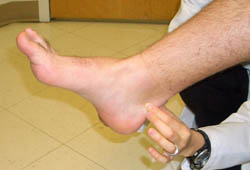Resumo
Definição
História e exame físico
Principais fatores diagnósticos
- presença de fatores de risco
- início insidioso
- sensibilidade bem localizada
Outros fatores diagnósticos
- dor durante atividade
- espessamento do tendão
- nodularidade do tendão
- crepitação
Fatores de risco
- atividades atléticas
- equipamentos inadequados
- superfícies de treino dura e de alta fricção
- idade mais avançada
- tratamento com fluoroquinolona
Investigações diagnósticas
Primeiras investigações a serem solicitadas
- diagnóstico clínico
Investigações a serem consideradas
- ultrassonografia
- RNM
- radiografia
Algoritmo de tratamento
ombro com tendinopatia do manguito rotador
ombro com tendinopatia no bíceps
cotovelo com epicondilite lateral
cotovelo com epicondilite medial
joelho com tendinopatia patelar
joelho com tendinopatia do poplíteo, quadríceps ou banda iliotibial
tornozelo com tendinopatia de Aquiles
Colaboradores
Autores
James H-C. Wang, PhD

Professor and Director
MechanoBiology Laboratory
Department of Orthopaedic Surgery
University of Pittsburgh School of Medicine
Pittsburgh
PA
Declarações
JHW declares that he has no competing interests.
Benjamin B. Rothrauff, MD, PhD
Research Fellow
UPMC Center for Sports Medicine
University of Pittsburgh
Pittsburgh
PA
Declarações
BBR declares that he has no competing interests.
Kevin J. Byrne, MD
Research Fellow
UPMC Center for Sports Medicine
University of Pittsburgh
Pittsburgh
PA
Declarações
KJB declares that he has no competing interests.
Agradecimentos
Dr James H-C. Wang, Dr Benjamin B. Rothrauff, and Dr. Kevin J. Byrne would like to gratefully acknowledge Dr Kivanc Atesok, Dr Chad Griffith, Dr Garth N. Walker, Dr Chealon Miller, Dr Paulo H. Araujo, Dr Margaret S. Lo, Dr Márcio Albers, and Dr Freddie H. Fu, previous contributors to this topic. Unfortunately, we have since been made aware that Dr Freddie H. Fu is deceased.
Declarações
KA, CG, GNW, CM, PHA, MSL, and MA declare that they have no competing interests. FHF declared that he had no competing interests.
Revisores
Per Renström, MD
Professor Emeritus
Karolinska Institute
Stockholm
Sweden
Declarações
PR declares that he has no competing interests.
Créditos aos pareceristas
Os tópicos do BMJ Best Practice são constantemente atualizados, seguindo os desenvolvimentos das evidências e das diretrizes. Os pareceristas aqui listados revisaram o conteúdo pelo menos uma vez durante a história do tópico.
Declarações
As afiliações e declarações dos pareceristas referem--se ao momento da revisão.
Referências
Principais artigos
Almekinders LC, Temple JD. Etiology, diagnosis, and treatment of tendonitis: an analysis of the literature. Med Sci Sports Exerc. 1998 Aug;30(8):1183-90. Resumo
Beaudreuil J, Dhénain M, Coudane H, et al. Clinical practice guidelines for the surgical management of rotator cuff tears in adults. Orthop Traumatol Surg Res. 2010 Apr;96(2):175-9.Texto completo Resumo
Schepsis AA, Jones H, Haas AL. Achilles tendon disorders in athletes. Am J Sports Med. 2002 Mar-Apr;30(2):287-305. Resumo
Kukkonen J, Joukainen A, Lehtinen J, et al. Treatment of nontraumatic rotator cuff tears: a randomized controlled trial with two years of clinical and imaging follow-up. J Bone Joint Surg Am. 2015 Nov 4;97(21):1729-37. Resumo
Artigos de referência
Uma lista completa das fontes referenciadas neste tópico está disponível para os usuários com acesso total ao BMJ Best Practice.

Diagnósticos diferenciais
- Ruptura do manguito rotador
- Doença de Osgood-Schlatter
- Doença de Sinding-Larsen-Johansson
Mais Diagnósticos diferenciaisDiretrizes
- ACR appropriateness criteria: chronic shoulder pain
- ACR appropriateness criteria: chronic elbow pain
Mais DiretrizesFolhetos informativos para os pacientes
Lesão do manguito rotador
Mais Folhetos informativos para os pacientesConectar-se ou assinar para acessar todo o BMJ Best Practice
O uso deste conteúdo está sujeito ao nosso aviso legal